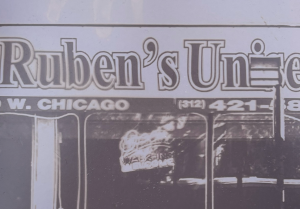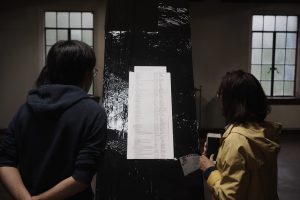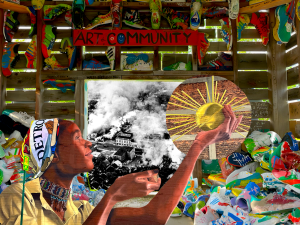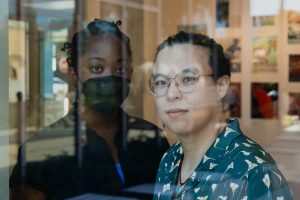Sacred Containers: Capsules, Conduits, and Other Stories was recently on view at the Chicago Artist Coalition. Curated by Curatorial Resident Christina Nafziger (2024-26) and featuring the work of Artist Residents Cecilia Beaven, FÁTIMA, and bex ya yolk (2024-26), the exhibition explores containers—both physical, through explorations of wombs and books, and metaphorical, through the idea of storytelling as a container for histories. The vessel, as a container, is positioned as the point of emphasis, pushing its content and context to take a backseat to the vessel itself. Piercing steel, stretchy ceramics, and dissolving paintings, the elasticity of each artists’ practice becomes an undeniable force in the room. The prevalent and pure skill of the artists comforts the viewer, as the materiality of each piece builds with precise intention.
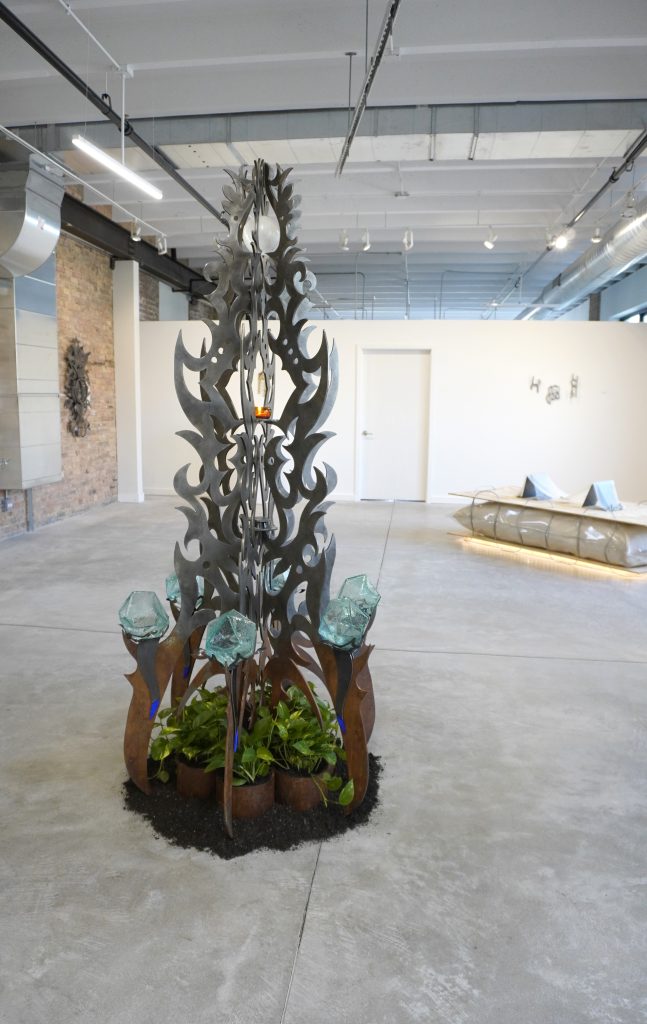
Cecilia Beaven opens the exhibition with Unbroken (scroll)—an artwork made of ink on rice paper that wraps around the top of the gallery wall. It reads like a film roll, with each still tip-toeing the tightrope of familiar and abstracted. Each drawing, roughly a foot apart, depicts a contorting figure that if viewed in isolation, appears to be an abstract floral symbol. There is only a subtle change between each image, generating a feeling akin to a sequence of shots in a stop-motion film. The floral symbol becomes animated and gestural, coming to life with thick, inky strokes. As the drawings teeter the line between flower and figure, a playful character emerges, introducing an element of folklore. The scale and repetition of the drawings structure the act of looking, turning the viewer’s movement along the wall into part of the work’s animation. A first view will lure the eyes in a lolling stroll through each frame, noticing the details of the individual rather than the fluidity of the whole. With subsequent viewings, the pace quickens. The details of the individual become the background noise to the mental moving image being summoned. The physicality of the piece, both the material and gestural, becomes the vessel to building a clear and ephemeral visual stimulus within the viewer, their eyes a lens, their brain the projector. The piece culminates feverishly rounding the gallery corner with Unbroken (Animation), a projection of the drawn frames ribboning the walls.


A bendy ceramic by Beaven, Cipactil Mamá, depicts a transcendent reptilian human figure folding over itself to reveal a womb-like hole containing a smaller creature nestled within. The womb, perfectly carved to support and hold the small figure curled up within it, becomes the critical vessel, responsible for the continuation of life. Vulnerability is introduced by the figure’s lack of painted surface, making it feel naked. At first glance, the mother with child morphs into what feels like a self-portrait of Beaven, carrying her inner child with them. In Beaven’s paper mache sculpture, Mujer Venado, a different but equidistant from reality figure is seen patiently perched on a gallery podium, legs crossed with hands in its lap. Its head is deer-like, with ears sharply scraping the air, while its entire surface is painted with the hues of a pond’s ecosystem come to life. Placed behind this work is Lean Down, an acrylic and oil painting of the same deer-like figure dipping down in a stance of strategy rather than submission. The flat, frozen painting feels like a scene from folklore, while the sculpture that is subtly animated by posture steps out from the memorialized painted world and turns that folklore into a story. Positioning these two works this way creates a relationship between them that says “that was then, this is now.” A generational history is passed on through the vessel of storytelling, where repetitions and retelling further crystallize it. Between the two-dimensional painted past and the three-dimensional sculpted present, the viewer steps into the role of a four-dimensional future.

In the center of the gallery is FÁTIMA’s sculpture, ALTEOKALLI, made of Earth, water, air, fire, aether, steel, glass, lazurite, and selenite. The outline of the sculpture’s body sharply divides the surrounding space with jutting precision. A steel flame, frozen at its proudest position, extends from a pile of dirt, lush plants spilling from the soil. Geometric glass bulbs of light blue evokes water, a small red flame at the heart of the body brings warmth, and a white lunar orb at the top of the piece breathes a soul. As the viewer circles the piece, a sense of ritual builds. This constructed gathering place becomes a container for humanity as it bids a sense of community, storytelling, and connectedness.
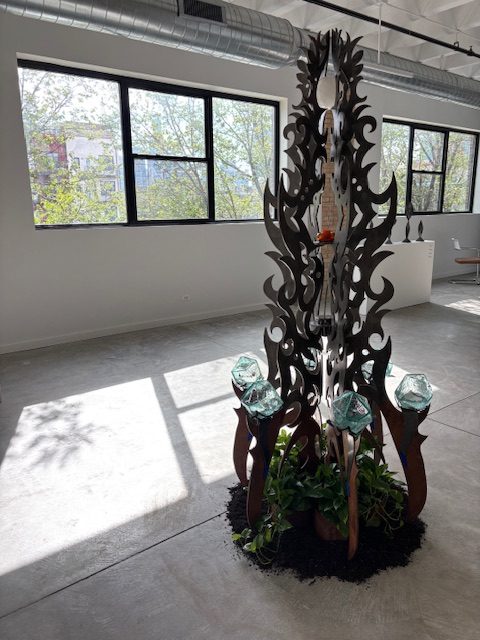
Movement is introduced to the space through bex ya yolk’s Artifacts we might not have inhibited, a sculpture made of steel, paper, sensor, motor, and stone. Perched on a podium at hip height is a steel platform with three planes. One plane containing a stone, one motor, and one book. The book’s pages appear empty, with one page peeled up, begging to be flipped. When the viewer reaches for the page, it flips. The motor positioned beneath the document is triggered by both the reach and pull back, flipping the page with bashful authority. bex ya yolk demonstrates an acute understanding of instinct, with the motor being placed at the specific location a person’s muscle memory would draw them to reach from. This piece demotes the book as the vessel for information; instead, the human instinct to reach toward information, discovery, and documentation becomes the container.

The exhibition is powerfully anchored by bex ya yolk’s The material plane, built of plywood, LED, steel cable, vinyl, and canvas. A pillowing rectangle held in a clear, plastic casing is sandwiched between two pieces of plywood with a steel cable snaking near the edge of the planes, holding the piece together. With the piece sitting near the previously mentioned Artifacts we might not have inhibited, a bookish familiarity emerges. Where the binding of a book might usually be considered the opening apparatus, the up and down stitch of the steel cable becomes the book’s seal as it snakes the perimeter completely. Though the size of a bloated coffin, the piece appears to float above the gallery floor, its weightlessness achieved by the balance of material with the subtle glow of light beneath the bottom plane. Despite its coffin-like scale, the piece retains an ethereal quality, with a bubbling sense of energy emerging from the piece’s stomach that curiously feels like a deep breath passing through space.
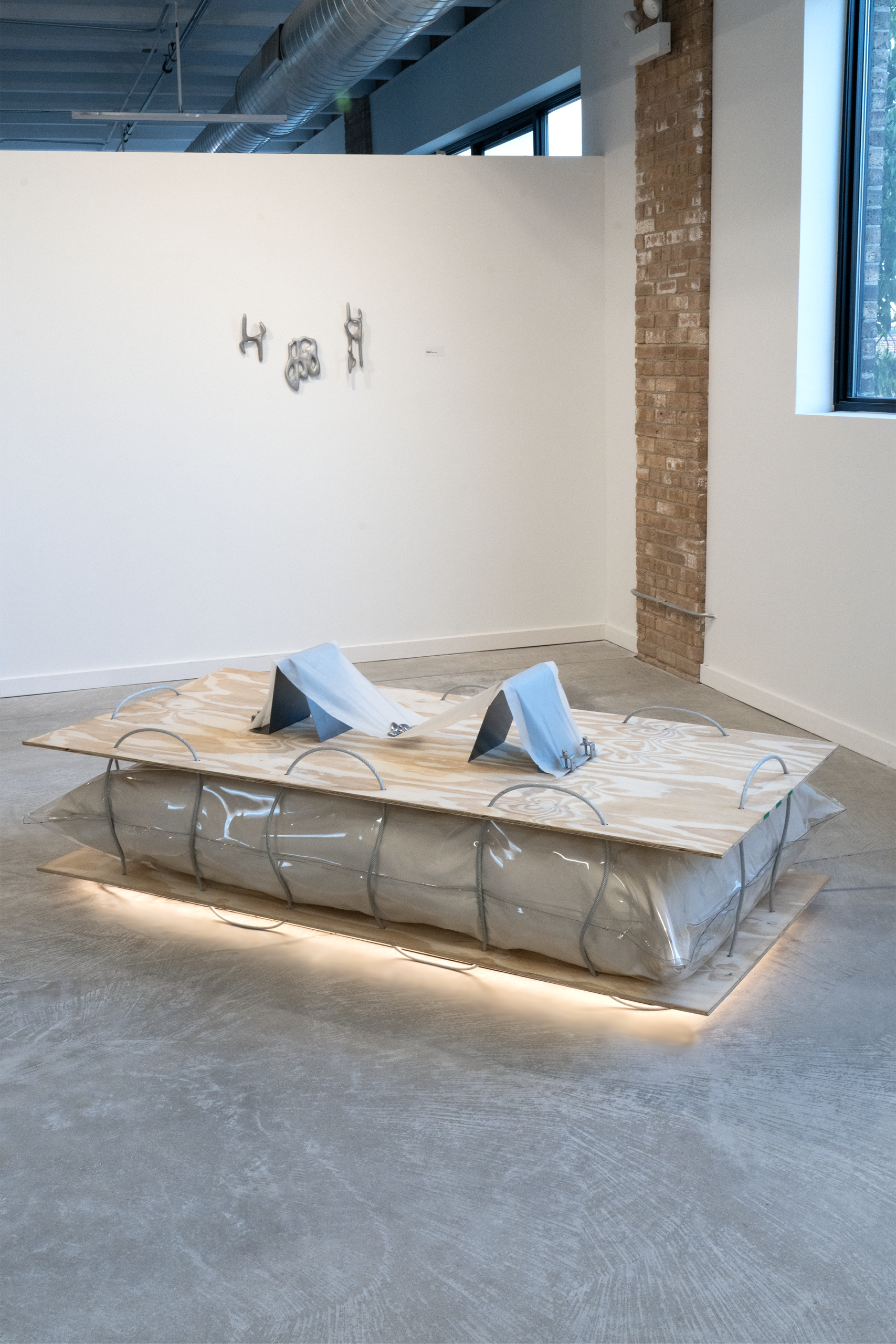
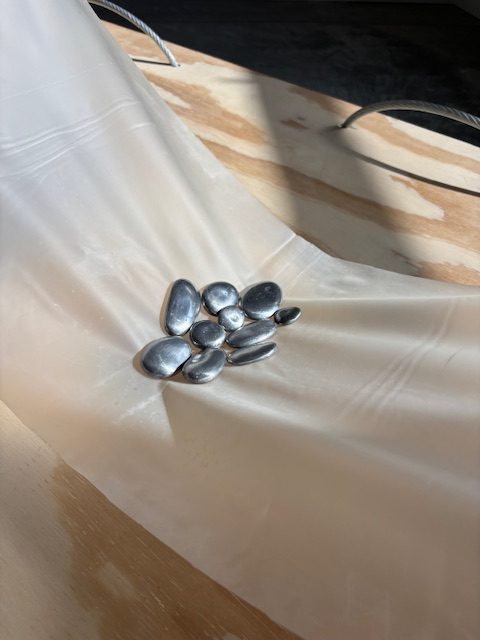

Nestled on top of The material plane is another piece by bex ya yolk titled stone babies. Two A-frame sheets of steel stand apart while a thin strip of latex stretches between them like taffy. Cradled between the frames on top of the latex is a pile of cast aluminum stones. While the piece beneath (The material plane) achieved a weightlessness at odds with its material, stone babies finds a complete heaviness, contrasting with the delicacy of its components. The latex deliberately slopes, keeping the stones gathered and elevated. The slight-sheerness of the latex feels fragile, like visceral fascia protecting an organ—one puncture from catastrophe. The term “stone babies” refers to a condition where an ectopic pregnancy causes a fetus to die and leads to the carrier’s immune system to respond by calcifying the fetus. In the wake of rolled back reproductive rights, this piece demands the viewer recognize the womb as a critical vessel in need of proper care. The pile of stone babies is haunting, a memorial to improper care and support. Positioning stone babies on top of The material plane summons the spectrum of a vessel, pairing strength with fragility, anchored in weightlessness, and static with elasticity.
Three strong artists, each with their distinct, clear conceptual visions, find a stunning harmony in Sacred Containers: Capsules, Conduits, and Other Stories. Nafziger expertly turned the gallery into a vessel for exploration, delivering a truthful throughline that stretches fluidly between the artists’ practices. The result is an exhibition that is a shell cracked open, ripe with contents, finding strength in sharing the vulnerability that lies within its protective containment.
“Sacred Containers: Capsules, Conduits, and Other Stories“ was on view at Chicago Artists Coalition from August 22 – October 9, 2025.

About the author: Ally Fouts is an arts writer and graphic designer based in Chicago, IL. She holds a BFA in Graphic Art, Media, and Design from DePaul University. With writing, she is especially interested in investigating alternative photography and sculptural work, and jumps at the chance to amplify dedicated arts workers through interviews. In addition to Sixty, she contributes writing to Newcity, and Chicago Reader.

